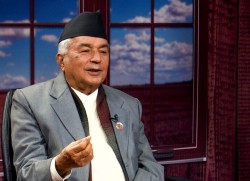Nepal

An earthquake of 4.7 Magnitude rocked central Nepal early in the morning on Monday, July 25. With its epicenter in Sindhupalchok - located northeast of Kathmandu - the earthquake was recorded at 6:07 am local time.
National Earthquake Monitoring and Research Center (NEMRC) reported the coordinates of the event between 27.94 latitude and 85.52 longitude, which lies near Helambu region.
If you thought it was a new earthquake, you would be wrong, as seismologists monitoring earthquakes in Nepal say it's yet another aftershock of one of the two big earthquakes that rocked Nepal, seven years ago, in April and May 2015.
“The earthquake is another aftershock of the 2015 earthquake,” senior divisional seismologist at NEMRC, Bharat Prasad Koirala, told NepalMinute.
Two major earthquakes rocked Nepal in 2015. The bigger with 7.6 Magnitude - epicentred in Gorkha - occurred in April; and nearly as big - epicentred in Dolakha - was recorded in May.
The quakes claimed the lives of over 9,000 people and destroyed around a million houses and buildings mostly in central and eastern Nepal.
Continuing aftershocks
According to Koirala, the center has recorded 580 noticeable aftershocks - which are equal to or over 4.0 Magniture - after the 2015 earthquakes.
Good news is that such aftershocks - including the one recorded on Monday - have not caused any damage.
“The Magnitude is not that high to cause any significant damages to buildings and infrastructures, we have not got any reports from Home Ministry,” Koirala added.
The United States Geological Survey (USGS), a US governmental agency involved in the earth sciences which also keeps track of earthquakes around the world, reported Monday's aftershock to be occurring at the depth of 10 kilometres.
To which, Koirala said: “We actually don’t keep track of depths, but we estimate that the latest one occurred at a depth of around 10 to 14 kilometres.”
Geo-hazards
Geologically, Nepal lies in an active seismic zone.
The constant shifting of the Indian plate against the Tibetan or Eurasian plate, the same phenomenon that resulted in the origin of the Himalayas millions of years ago, have been causing earthquakes.

Researchers suggest that Nepal lies in the subduction zone between Indian and Eurasian plates in which Indian plate is pushing against the other at the rate of a few millimetres per year – like a “slow car-crash”.
This has caused a lot of fault zones underneath the Himalayan region, including Nepal, India, Bhutan, Pakistan, China, and, scientists say, these earthquakes are the rumbles in the fault zones.
With such geo-hazards underneath the Himalayas, experts have been urging governments and communities across the region to stay prepared with solid buildings and infrastructure that can withstand the impacts of bigger earthquakes.






